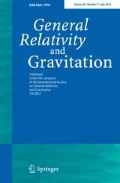Abstract
The Wheeler-DeWitt equation is applied to closedk>0 Friedmann-Robertson-Walker metric with various combination of cosmological constant and matter (e.g., radiation or pressureless gas). It is shown that if the universe ends in the matter dominated era (e.g., radiation or pressureless gas) with zero cosmological constant, then the resulting Wheeler-DeWitt equation describes a bound state problem. As solutions of a nondegenerate bound state system, the eigen-wave functions are real (Hartle-Hawking). Furthermore, as a bound state problem, there exists a quantization condition that relates the curvature of the three space with the various energy densities of the universe. If we assume that our universe is closed, then the quantum number of our universe isN∼(Gk)−1∼10122. The largeness of this quantum number is naturally explained by an early inflationary phase which resulted in a flat universe we observe today. It is also shown that if there is a cosmological constant Λ>0 in our universe that persists for all time, then the resulting Wheeler-DeWitt equation describes a non-bound state system, regardless of the magnitude of the cosmological constant. As a consequence, the wave functions are in general complex (Vilenkin).
Similar content being viewed by others
References
Dirac, P. A. M. (1964).Lectures on Quantum Mechanics (Belfer Graduate School of Science Monographs 2, Yeshiva University, New York).
Wald, R. M. (1984).General Relativity (University of Chicago Press, Chicago).
Arnowitt, R., Deser, S., and Misner, C. W. (1963). InGravitation: An Introduction to Current Research (Wiley, New York).
DeWitt, B. S. (1967).Phys. Rev. 160, 1113.
Wheeler, J. A. (1968). InBattelle Rencontres: 1967 Lectures in Mathematics and Physics, C. M. DeWitt and J. A. Wheeler, eds. (Benjamin, New York).
Misner, C. W. (1972). InMagic Without Magic: John Archibald Wheeler Festschrift, J. R. Klauder, ed. (Freeman, San Francisco).
Halliwell, J. J. (1988).Phys. Rev. D 38, 2468.
Misner, C. W. (1970). InRelativity, M. Carmeli, S. I. Fickler, and L. Witten, eds. (Plenum, New York).
Hawking, S. W., and Page, D. N. (1986).Nucl. Phys. B 264, 185.
Blyth, W. F., and Isham, C. J. (1975).Phys. Rev. D 11, 768.
Christodoulakis, T., and Zanelli, J. (1984).Phys. Lett. 102A, 227.
Esposito, G., and Platania, G. (1988).Class. Quant. Grav. 5, 937.
Gibbons, G. W., and Grishchuk, L. P. (1988).Nucl. Phys. B 313, 736.
Hartle, J. B., and Hawking, S. W. (1983).Phys. Rev. D 28, 2960.
Hawking, S. W. (1984).Nucl. Phys. B 239, 257.
Vilenkin, A. (1986).Phys. Rev. D 33, 3560.
Vilenkin, A. (1986).Phys. Rev. D 37, 888.
Narlikar, J., Padmanabhan, T. (1986).Gravity, Gauge Theories and Quantum Cosmology (Reidel, Dordrecht).
Misner, C. W., Thorne, K. S., and Wheeler, J. A. (1973).Gravitation (W. H. Freeman, San Francisco).
Ringwood, G. A. (1976).J. Phys. A: Math. Gen. 9, 1253.
Cheng, K. S. (1972).J. Math. Phys. 13, 1723.
Peleg, Y. (199?). Preprint, Brandeis University, BRX-TX-342.
Arfken, G. (1970).Mathematical Methods for Physicists (Academic, New York).
Gradshteyn, I. S., and Ryzhik, I. M. (1965).Table of Integral, Series, and Products (Academic, New York).
Merzbacher, E. (1970).Quantum Mechanics (Wiley, New York).
Guth, A. (1981).Phys. Rev. D 23, 347.
Kolb, E. W., and Turner, M. S. (1990).The Early Universe (Addison-Wesley, New York).
Linde, A. D. (1984).Sov. Phys. JETP 60, 211.
Vilenkin, A. (1984).Phys. Rev. D 30, 549.
Rubakov, V. A. (1984).Phys. Lett. 148B, 280.
Zel'dovich, Ya. B., and Starobinskii, A. A. (1984).Sov. Astron. Lett. 10, 135.
Albrecht, A., and Brandenberger, R. (1985).Phys. Rev. D 31, 1225.
Kung, J. H., and Brandenberger, R. (1989).Phys. Rev. D 40, 2532.
Kasner, E. (1921).Am. J. Math. 43, 217.
Schücking, E., and Heckmann, O. (1958). InOnzieme Conseil de Physique Solvay (Editions Stoops, Brussels).
Misner, C. W. (1969).Phys. Rev. Lett. 22, 1071.
Author information
Authors and Affiliations
Rights and permissions
About this article
Cite this article
Kung, J.H. Quantization of closed mini-superspace models as bound states. Gen Relat Gravit 27, 35–53 (1995). https://doi.org/10.1007/BF02105672
Received:
Issue Date:
DOI: https://doi.org/10.1007/BF02105672


